Birds display an astonishing variety in the forms and colors of their bills. Birds of prey, known as raptors, possess hooked bills designed for ripping apart their quarry. Shorebirds, with their extended, slender bills, are expertly adapted to pull out invertebrates hidden in sandy coastlines. Finches, on the other hand, utilize their strong, hefty bills to break open seeds. For birdwatching novices, a vibrant yellow bill is a distinguishable characteristic. In this article, we’ll delve into the distinctive features of 21 species of birds that sport yellow bills, accompanied by photos.
21 BIRDS WITH YELLOW BEAKS
1. BALD EAGLE

Scientific name: Haliaeetus leucocephalus
Witnessing a Bald Eagle elegantly navigating the skies is a truly captivating experience. This regal creature, despite being one of the few eagle species native to the United States, has earned its status as our national emblem. It primarily inhabits areas adjacent to bodies of water, which provide ample fishing opportunities, though it may also opportunistically feed on the kills of other animals.
The bird’s vivid yellow beak is striking against its head, which is adorned with contrasting white plumage. Large congregations of Bald Eagles can be observed around North American lakes and dams, especially during the colder winter months. Once on the brink of extinction due to the use of DDT, the Bald Eagle has made a remarkable recovery thanks to diligent conservation efforts.
2. PYRRHULOXIA
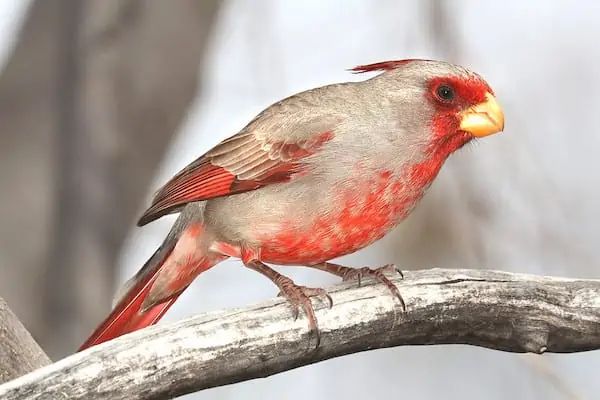
Scientific name: Cardinalis sinuatus
The jovial Pyrrhuloxia, with its crest and finch-like beak, might bring to mind a cardinal. While the two species are indeed related, they inhabit different areas within North America. The Pyrrhuloxia is typically found in the southwestern states of the United States. It favors the harsh desert environments of Arizona, New Mexico, and western Texas as its home.
Pyrrhuloxias are attracted to feeders that offer seeds they can crack open. In their natural habitat, their diet comprises seeds, fruits, blossoms of the saguaro cactus, and insects such as grasshoppers and beetles.
3. MALLARD
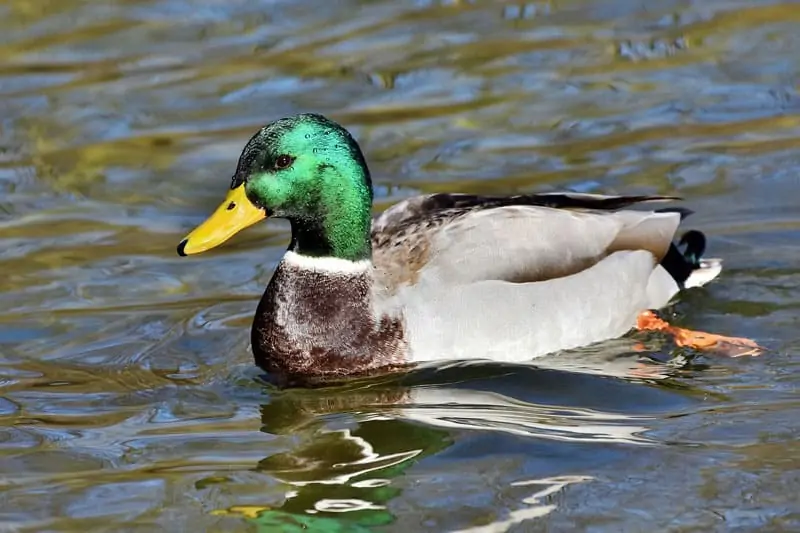
Scientific name: Anas platyrhynchos
This native North American duck is among the most recognizable birds worldwide. Only male mallards sport yellow beaks, a feature that complements their stunning, iridescent green heads during mating season.
Mallards are often spotted in parks, even within city limits, and are typically unafraid of humans. While feeding them can be enjoyable, it’s crucial to ensure that the food offered isn’t harmful. These ducks can be spotted across most of America throughout the year, and they extend their range to include Canada during the breeding season.
4. EVENING GROSBEAK

Scientific name: Coccothraustes vespertinus
The male evening grosbeak is easily noticeable with its radiant yellow body, forehead, and light yellow beak, while females exhibit more subdued yellow and gray hues. These large finches reside year-round in the coniferous forests of Canada and certain northern American regions. Populations have been established in some states, with expansion expected across the country. During winter, they may occasionally be spotted further south as some populations migrate.
Interestingly, despite being classified as a songbird, they don’t sing. Unlike many birds that use intricate sounds and songs to woo their mates, evening grosbeaks only produce a handful of simple calls.
5. YELLOW-BILLED CUCKOO
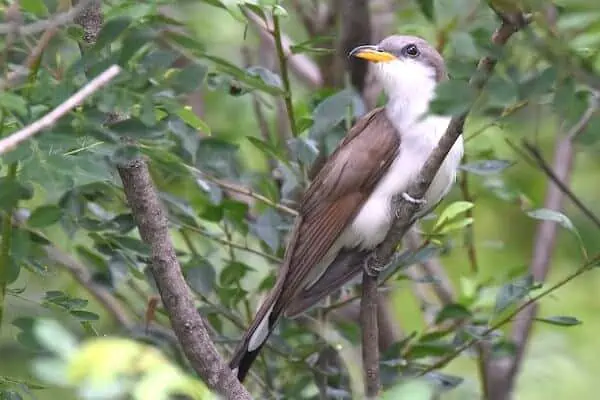
Scientific name: Coccyzus americanus
This migratory cuckoo is seen in the United States only during the warmer spring and summer months. The yellow-billed cuckoo travels through the forests of the eastern United States for breeding and raising its offspring.
Typically, this songbird is heard more frequently than it is seen. It tends to perch patiently while hunting for caterpillars, producing a sound reminiscent of knocking. Both females and males collaborate to raise their young, which are among the quickest growing birds globally, with juveniles reaching maturity in a mere 17 days.
6. EUROPEAN STARLING

Scientific name: Sturnus vulgaris
This songbird was introduced to the United States in the late 1800s by a man who wished to populate Central Park with every bird species mentioned in Shakespeare’s works. His aspiration for the European Starling to flourish in the temperate climate was realized far beyond his expectations. Now, this bird can be found in the United States, Canada, and northern Mexico.
Although they may initially seem black, under certain lighting conditions, their iridescent plumage reveals shades of purple and green. However, European Starlings are often regarded as a nuisance due to their habit of forming massive flocks that can displace other birds. They’re notorious for consuming large amounts of seed and monopolizing bird feeders in backyards.
7. AMERICAN ROBIN

Scientific name: Turdus migratorius
The joyful tune of an American robin provides the quintessential soundtrack to spring mornings. This insect-eating bird delights in foraging for worms in the early dawn hours. There’s no need to supply seeds as they find ample hunting territory on lawns.
Both male and female American robins boast yellow beaks, which, combined with their striking orange-red breasts, make them easy to identify. These birds can be found across all states, including Alaska.
8. MASKED BOOBY

Scientific name: Sula dactylatra
These stunning seabirds are characterized by their white bodies, black tails and wingtips, black-rimmed faces, and sizable yellow beaks. They are typically found in tropical waters, so you might spot them in places like Hawaii or Dry Tortugas National Park in Florida. They occasionally show up in the Gulf Stream off North Carolina’s coast, although you’d need to be on a boat to catch a glimpse.
Male birds often adorn the periphery of their nest with items such as seashells, coral, and small stones. This particular species of booby nests on the ground, laying its eggs in a shallow hollow.
9. CLARK’S GREBE
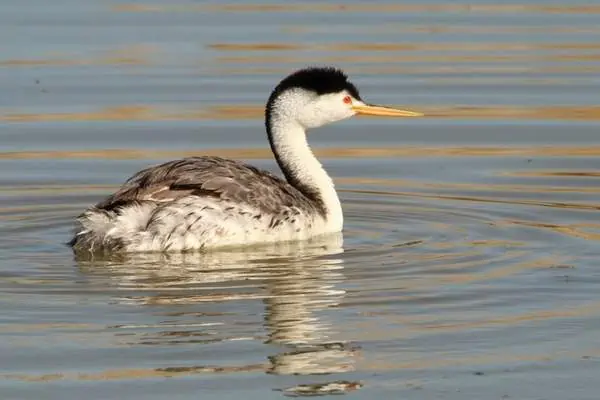
Scientific name: Aechmophorus clarkii
Endemic to the Western United States, Clark’s grebe is a stately waterbird that exudes grace and dignity. It inhabits the inland west during most of the year but moves to the Pacific Coast in winter. You might get a chance to spot one if you visit marshy areas with vegetated shores.
Both male and female of the species sport the distinctive yellow beak, a black crest, and a vivid red eye. Much like their western grebe relatives, they engage in elaborate synchronized courtship displays that give the illusion of dancing on water.
10. SORA
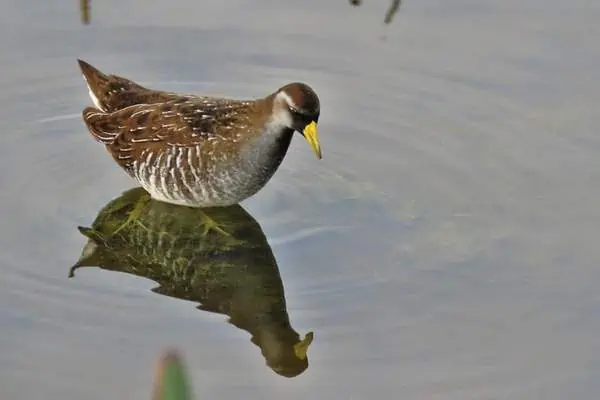
Scientific name: Porzana carolina
Spotting a sora in its natural habitat is quite a rare treat! These shy waterbirds frequent the cattails and rushes surrounding freshwater marshes and lakes. Despite their brown plumage, they have yellow beaks and legs. To identify them, it’s best to look for their beak first, though binoculars might be necessary.
Soras’ calls resemble the whinny of a horse. They are also known by other names, such as “Carolina rails” and “meadow chickens”.
11. RED PHALAROPE

Scientific name: Phalaropus fulicarius
This long-distance migrant breeds in the remote Arctic and spends its winter along the western coast of South America. During migration, you might spot them along the United States’ coastlines, as well as in certain southern coastal regions where they overwinter.
Like many migratory species, the Red Phalarope sports a yellow beak only during a specific period of the year. The beak color of adult birds transitions from black to vibrant yellow as they shed their old feathers for their reddish breeding plumage. Their plumage shifts to white and gray in the winter, and their beak reverts to a darker color. The female phalarope, larger and more colorful, lays her eggs and then leaves her partner to incubate them and rear their offspring.
12. RING-BILLED GULL

Scientific name: Larus delawarensis
Gulls are not exclusively coastal birds. The ring-billed gull, found from southern Canada to Mexico, is a widespread breeder across North America. These birds nest in freshwater areas such as lakes and ponds, venturing inland, though they can also be seen along coastlines and beaches.
Both males and females sport bright yellow beaks distinguished by a dark gray ring. They prefer to breed in gravelly spots on the ground in the northern United States and southern Canada, where they establish their nests.
13. LEAST BITTERN
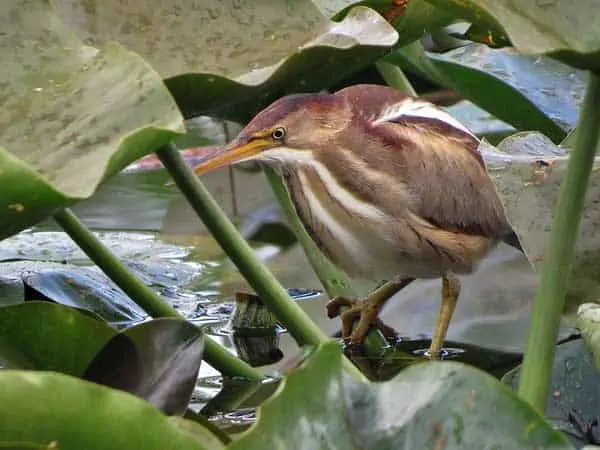
Scientific name: Ixobrychus exilis
The least bittern is a timid yet nimble waterbird from freshwater marshes and wetlands, known for its pale yellow beak which enables it to blend seamlessly into its surroundings. Being smaller than other bitterns, it has the unique ability to perch on reeds and cattails over the water, affording it an advantageous vantage point to hunt for prey in the cloudy waters below.
One standout feature of least bitterns is their extendable necks. They frequently employ these necks during hunting, stretching them out in an attempt to seize their prey. When threatened, they sway in a manner that mimics the movement of cattails, enhancing their camouflage.
14. GREAT BLUE HERON

Scientific name: Ardea herodias
If you visit a river or ocean, particularly the estuaries and riverside areas near open water, chances are high you’ll encounter a Great Blue Heron. These impressive birds, the largest heron species in North America, can be found throughout most of the United States all year round. Both males and females have yellow beaks that beautifully contrast with their blue-gray plumage.
They are patient hunters, staying motionless in the water, waiting for a fish to venture close enough. When the moment is right, they extend their long necks and strike with astonishing speed.
15. BARRED OWL

Scientific name: Strix varia
The voice of a barred owl is often heard before the bird is spotted. These nighttime predators are swift, silent, and can be elusive to the eye. However, thanks to their distinctive calls, which resemble the phrase “who-cooks-for-you,” identifying their nesting and perching locations can be straightforward.
Barred owls are indigenous to the forests of the eastern United States, the northern Great Plains, and the Pacific Northwest. They tend to be quiet during daytime, but you might spot them resting in trees while strolling through a forested area.
16. PEREGRINE FALCON
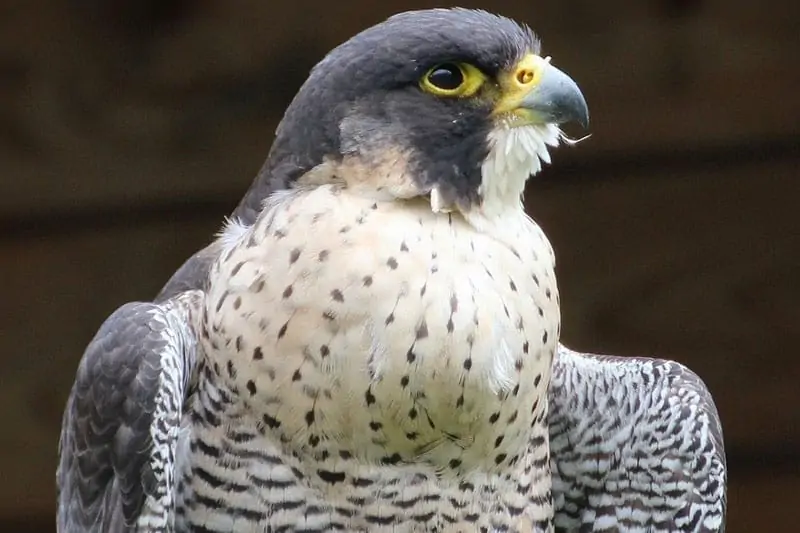
Scientific name: Falco peregrinus
This swift and bold avian acrobat can be easily recognized by its creamy, speckled underparts and its distinctive gray head with yellow accents around the eyes. The Peregrine Falcon’s beak, yellow with a black, hooked tip, is a standout feature.
This raptor is another species that, by the mid-twentieth century, had almost been entirely wiped out due to DDT poisoning. Today’s populations, however, can be seen migrating through the central states and inhabit scattered regions across North America. They have particularly adapted well to urban environments with high-rise buildings and coastal towns.
17. YELLOW-BILLED MAGPIE

Scientific name: Pica nuttali
Aside from its striking yellow beak, the yellow-billed magpie closely resembles its more widespread relative, the black-billed magpie. This bird is endemic to central California and inhabits a remarkably confined range. They can be spotted in the brushlands surrounding farmlands and in areas of the Sierra Nevada foothills.
The yellow-billed magpie’s habitat is currently under threat due to the expansion of agricultural fields in California’s Central Valley. They are also grappling with the impact of the West Nile virus. Given their sensitivity to changes in their habitat, scientists and conservationists are closely monitoring this species.
18. GRAY-CROWNED ROSY-FINCH

Scientific name: Leucosticte tephrocotis
The hardy gray-crowned rosy finches are able to withstand high winds, snow, and frigid temperatures due to their native habitats in the severe mountainous regions of the northern Rockies, Cascades, and even the Aleutian islands.
During winter in the northern Rockies, these petite finches can be enticed with seeds scattered on the ground. This mimics their natural feeding behavior in alpine regions above the tree line, where they are accustomed to foraging for seeds on the ground.
19. LAPLAND LONGSPUR
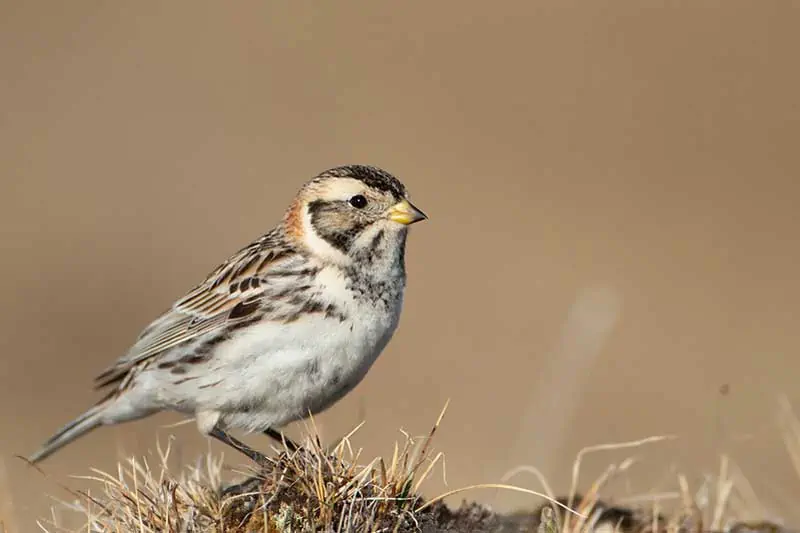
Scientific name: Calcarius lapponicus
The Lapland longspur, an insectivorous songbird, has a rather muted appearance during the winter, characterized by a brown beak and a predominantly brown and white body. However, everything changes in the breeding season. The males transform, molting into a striking mix of white, rust, and black, and their beaks turn yellow as they assemble in large flocks.
The bird is named after the lengthy spur on each of its hind claws and its breeding grounds in Lapland, a region in Scandinavia. This is the only longspur species found outside North America. During the winter, they migrate to the United States, where they can be spotted on agricultural lands and urban pavements, typically mingling with other bird flocks.
20. HERRING GULL
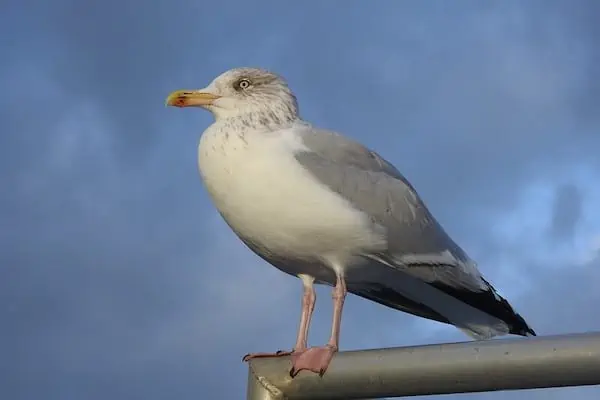
Herring gulls, the iconic seagull species, reside all year round in the northeastern coastal regions and the north Atlantic. They also migrate between northern Canada and the southeastern United States, extending their reach to Mexico and the California coast. During their migration period, these birds are a common sight across the country.
During the mating season, both males and females shed their speckled gray plumage to don creamy white feathers. Their beaks, adorned with a distinct red mark on the lower side, transition to a bright golden yellow. A breeding pair collaborates to nurture their offspring. It’s estimated that older chicks consume approximately half a pound of food daily.
21. GREAT EGRET

Scientific name: Ardea alba
The striking Great Egret is the chosen symbol for the National Audubon Society, reflecting its commitment to preventing the massacre of birds for their feathers. The Great Egret was on the brink of extinction due to the high demand for its feathers, which were used extensively in hat decorations during the late 19th century. The prohibition of plume hunting in the early 20th century thankfully rescued this bird species.
These captivating creatures can be spotted year-round along the east coast of the United States, and they make their way to the west coast during winter. During the latter part of summer and into fall, they can be found near various water bodies across the United States.
